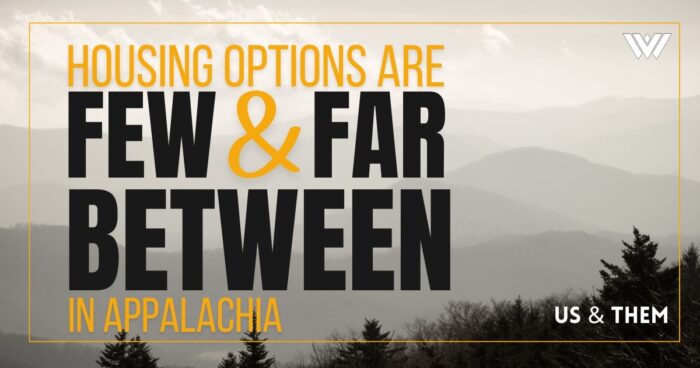Your browser doesn’t support audio playback.
Home ownership in America is one of the most common ways to build wealth for future generations.
But in Appalachia, West Virginia presents the complexities and nuances of that reality. The Mountain State has the nation’s highest homeownership rate but the second lowest personal income rate.
And there’s another reality at work. Much of that housing is old and needs repair. In one West Virginia county, 67 percent of the homes are more than 80 years old and half rate below normal on standard quality measures. One estimate shows there are 500,000 people living in such conditions. This is a side of the housing crisis we don’t often hear — structures in disrepair without electricity, or running water, that people call home.
This episode of Us & Them is presented with support from the CRC Foundation.
Subscribe to Us & Them on Apple Podcasts, NPR One, RadioPublic, Spotify, Stitcher and beyond.
Courtesy of FAHE
“We have about 3.8 million households in Appalachia, and by several measures, there are half a million people living in homes built before 1930 or in families earning less than 30% of area median income. Cuts to the HUD budget this year have hit federal assistance hard, leaving people with less buying power. All things equal, if your income is very low, your ability to find a decent place to live is very limited.”
– Jim King., CEO of FAHE
Photo Credit: Trey Kay/West Virginia Public Broadcasting
“Back then I would get the water in a barrel for cleaning and cooking and all that stuff. I got a big pot out there that I use heat water in to bathe and stuff. I used wood and had a flue that I had built in for heat.”
– Joyce Vest
Photo Credit: Trey Kay/West Virginia Public Broadcasting
“I just realized when I came out here that that’s not a way for her to live, and if I could help her, we were going to do so. We started searching and looking [to find a service to help], and it took a couple of years before we had the house. It was one of those things that was on my heart that I had to do. To be honest, I didn’t realize people lived like that — without electricity and without water. I’m not sure how she did it, but she did. She managed. It was an eye-opening experience for me, and it made me realize that I needed to do some things.”
– Stacy Reeder, a veterinarian in rural Virginia
Photo Credit: Trey Kay/West Virginia Public Broadcasting
“The Indoor Plumbing & Rehabilitation program is designed for low- to moderate-income homeowners who have no indoor plumbing, no potable water or a failed septic system. In her case, she had no well, no indoor bathroom and no septic system—so she fit the qualifications for the IPR program. It’s a common challenge: even if a septic system was installed 50 years ago, it may now have failed or be underperforming and must be replaced to meet new water regulations and prevent groundwater contamination. And if someone who is 70 or 80 years old—who has lived in their home for decades—suddenly finds that their septic system has failed, they may be forced to install an alternative system that can cost up to $40,000, an expense unaffordable on a fixed income.”
– Kenneth Rogers, rural housing specialist with Southeast Rural Community Assistance Project (SERCAP)
(Pictured above) Kenneth Rogers showed Us & Them host Trey Kay two composites: before-and-after photographs of Joyce Vest’s home, taken before SERCAP built a new structure with electricity and running water. Courtesy of SERCAP
Photo Credit: Trey Kay/West Virginia Public Broadcasting
Photo Credit: Trey Kay/West Virginia Public Broadcasting
Photo Credit: Trey Kay/West Virginia Public Broadcasting
“That means their families haven’t accumulated the wealth needed to pass on from generation to generation to ensure stability. People my age — and I’m among the oldest millennials — can buy homes largely because of intergenerational wealth. Without that, you lose access to safe, stable housing. Anyone could become homeless at any time — a huge medical expense could wipe you out and leave you on the street. We hear stories like that, but housing insecurity is mostly rooted in generations of being left out. We see it in Appalachia, where people live in old trailers, and in urban areas, where tenants endure poorly maintained rental homes while paying high rents. This isn’t so much a political divide as it is the result of setting our country on a wealth-building track that didn’t include everyone — and still doesn’t. It’s become an us-and-them scenario.”
– Mel Jones, co-director of the Virginia Center for Housing Research at Virginia Tech University
